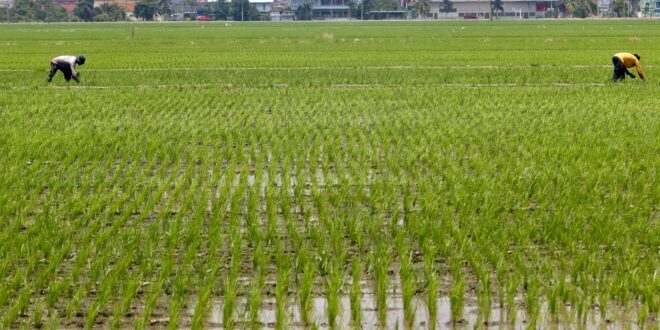FARMERS everywhere have always faced challenges. For paddy growers in the rice-bowl states of Perlis and Kedah, the rising mercury in recent years, coupled with higher costs and lack of access to high-quality seeds, have made life even tougher.
Their children seldom take over as they drift off to less physically taxing jobs in the cities, leaving a handful of farmers who not only tend to their own plots but also lease their neighbours’ plots to give them economies of scale.
Paddy farmers need at least a 5ha plot to make a decent living. They also need to plant other crops that can tide them over to the next season.
A number of them cultivate the Harumanis mango. Others may have homestay businesses to sustain their livelihood. Times may get tougher soon as more frequent dry spells are predicted.
Considering that Indian rice exports make up 40% of global rice trade, countries where rice is a staple diet have felt the impact of India’s export ban on non-basmati white rice last July.
Malaysia, which imports just over a third of its rice needs, has taken measures to keep prices down and ensure stable supply. The short-term measures, including higher subsidies for farmers and lowering white rice prices, are unsustainable.
For one thing, hotter weather will result in less rain. Rice yields and cash crop yields could be adversely affected by severe dry spells, as predicted in 2018 by the Energy, Science, Technology, Environment and Climate Change Ministry, for next year and in 2026.
Livestock will also be affected while reduced raw water supply may mean rationing of potable water, even affecting the manufacturing sector.
The current hot spell has definitely affected paddy yields in Perlis and Kedah. Costlier fertiliser is a major problem, low-quality seeds is another. Aid to farmers is irregular.
“The weather is important as changing weather patterns can affect yields,” one farmer notes, adding that paddy from low-quality seeds can cause weed infestation that will halve the yield.
The government is targeting a yield of 2.03 million tonnes of white rice in 2024 and 2.01 million tonnes in 2025, which is well above the 1.57 million tonnes produced in 2022 and 1.68 million tonnes in 2021. According to the UN’s Food and Agriculture Organisation (FAO), Malaysia’s 2023 aggregate paddy production is forecast at a near‑average of 2.5 million tonnes.
While there are plans to increase rice production to reduce imports and increase food security, the most concerning fact is that 90% of farmers in Kedah and Perlis under the Muda Agricultural Development Authority (Mada) failed to get seeds in time for the second planting season at the end of last year, a recurring problem that is exacerbated by a cartel that controls these seeds and fertilisers. Quality seeds produce white rice that can be sold.
It is learnt that many have no choice but to buy seeds from outside suppliers at three times the normal price. Farmers who cannot afford this have to forego planting for that season.
The Agriculture and Food Security Ministry needs to ensure “rats” do not eat up the funds allocated to these farmers, many of whom are already in debt. Farmers do not benefit from price controls, which are short-term measures to ensure access.
The FAO noted that around 85% of the main rice crop is cultivated under irrigation in the northern parts of Peninsular Malaysia, which actually places a lot of risk on food security as a major drought or blight in the region could severely affect production.
There are plans to open up more land for paddy planting in Johor, Negri Sembilan, Sabah and Sarawak. A pilot project to have five paddy planting seasons in two-year periods and Sekinchan-style farming, named after the area in Selangor with famously high rice yields, has been introduced in certain areas.
Besides having to deal with rising temperatures in the north of the peninsula in the first quarter of 2024, farmers are increasingly worried about water security, given the El Nino weather conditions and subsequent dry spell.
Farmers under Mada are not so badly affected but others have to depend on rain and whatever is available in the canals.
Technology has been touted as a solution but to farmers, the main concern is cost. For those in the main rice-growing areas of Kedah and Perlis, the government must address the water issue and supply of seeds and fertilisers.
Another solution is urban farming, which has yet to take root in Malaysia. FarmByte CEO Aiman Syed Jaafar says urban farming is a viable option that can also enhance food security by decentralising food production and distribution networks.
“In times of crisis and global supply chain disruptions such as during the Covid-19 pandemic or climate disasters, locally grown produce can serve as a resilient source of nutrition for urban populations,” he says.
However, for urban farming and agritech solutions to really take off, a concerted, whole-of-society action is needed. Agritech solutions can make the agrofood ecosystem more resilient to climate change by leveraging real-time data, predictive analytics, artificial intelligence (AI) and machine learning.
“With such technology at play, farmers are empowered to make better informed decisions that can not only optimise crop productivity and increase production, but also minimise resource inputs and environmental degradation,” Aiman adds.
This article first appeared in Star Biz7 weekly edition.
 BeritaKini.biz Berita Viral Terkini di Malaysia
BeritaKini.biz Berita Viral Terkini di Malaysia





